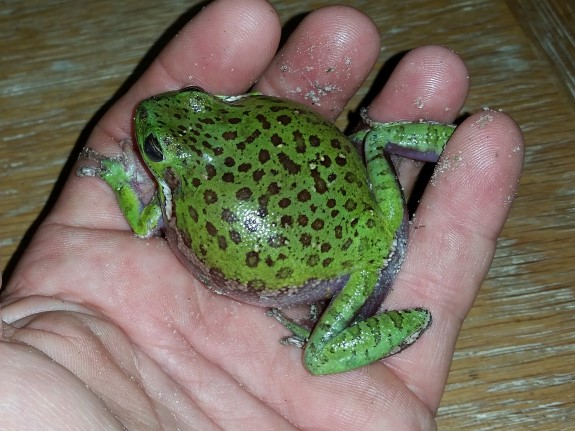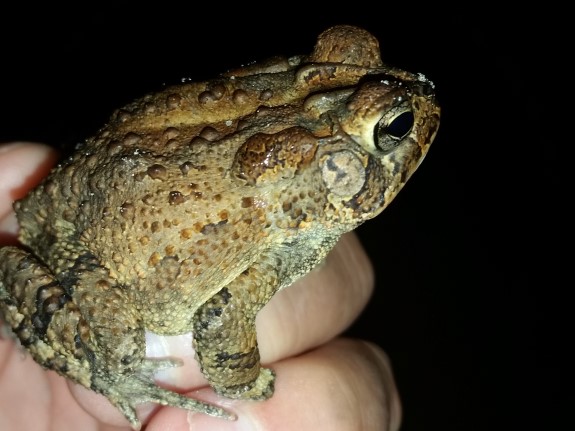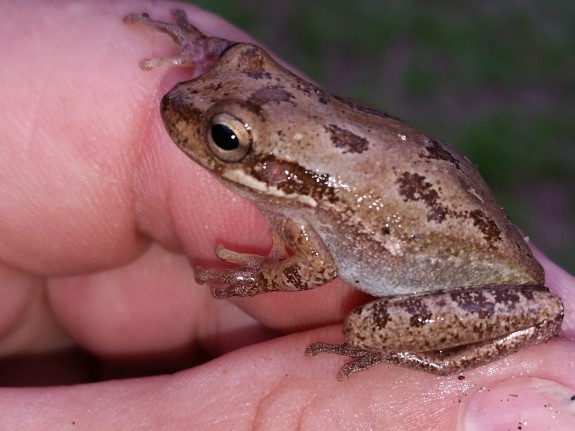Lately, the night sounds in our mid-Panhandle woodlands have reached a crescendo of deafening levels. It is even difficult to identify individual players in the band as everybody gets in on the action at the same time. Most of us are familiar with the usual summertime stridulations of crickets and katydids but during early June we had a special event that added millions of other singers to the chorus. Tropical storm Cristobal brought 7-8 inches of rain to many portions of the region and frogs and toads came out of the woodwork to make their way to low areas that suddenly had water in them. The sound of their breeding choruses can reverberate so loudly at times that it feels like it is echoing inside one’s head as you approach a wetland. The heavy rains have awakened local species to the notion that there is no time like the present for pro-creation; given the fact that many of the shallow, depressional wetlands will only contain water for a short window of time. This may seem like a drawback to the life style of frogs and toads that depend on these temporary wetlands but nature has a way of surprising us with incredible adaptations for survival.

For instance, the eastern spadefoot toad (Scaphiopus holbrookii) (so-named for the small, hard, sickle-shaped “spade” on the hind feet that aids in digging) can actually survive through several years with no water available for raising their young. They do this by remaining buried in the ground, only emerging after heavy rains that collect in depressions. Tadpoles metamorphose into small toads within 28 days so by the time the pool goes dry they are likely long-gone. Female spadefoots will lay over 2,000 eggs at a time so the number of progeny that can emerge from a small depressional wetland is phenomenal. I recall seeing black stains across roadways all over the County about a month after Tropical Storm Debbie. Baby spadefoot toads were dispersing by the millions from hundreds of shallow pools across the region and local roadways were one of the hazards they faced on their journey.

Another advantage to amphibians breeding in ephemeral (temporary) wetlands has to do with the fact that there are no fish to prey on the tadpoles. This is not a requirement for all species, as some have chemical defenses (bad taste) that limit predation, but others could not successfully breed in permanent bodies of water with a population of fish.

Some of the species I have heard calling lately include squirrel treefrogs, green treefrogs, Cope’s gray treefrogs, southern toads, cricket frogs, barking treefrogs and a few others I have not identified yet. If you have never made an effort to identify the night calls of frogs and toads, you do not know what you are missing in your local environment. Some are quite difficult to separate (especially at the sub-species level) but many are very distinct and once you put the call with a name you won’t ever forget it. Take a moment to go to the Florida Museum’s website at (https://www.floridamuseum.ufl.edu/science/florida-frog-calls/) and run through the list. One of my favorites is the southern toad; the origin of a beautiful, high-pitched trill that you most likely have never paid much attention to. The southern cricket frog call sounds like two marbles clacking together, and Copes’ gray treefrogs are likely mistaken for a bird as they trill from high in the tree canopy. A chorus of spring peepers is the one that will really make your brain feel like it is vibrating, but I typically hear them earlier in the spring or even into the early fall.
The cacophony of sounds on a warm summer’s night can seem chaotic and random but if you spend a little time sorting out the musicians, you are sure to develop a deeper appreciation of the symphony, along with a better understanding of the well-orchestrated cycles of nature in your mid-Panhandle woodlands.
 0
0
